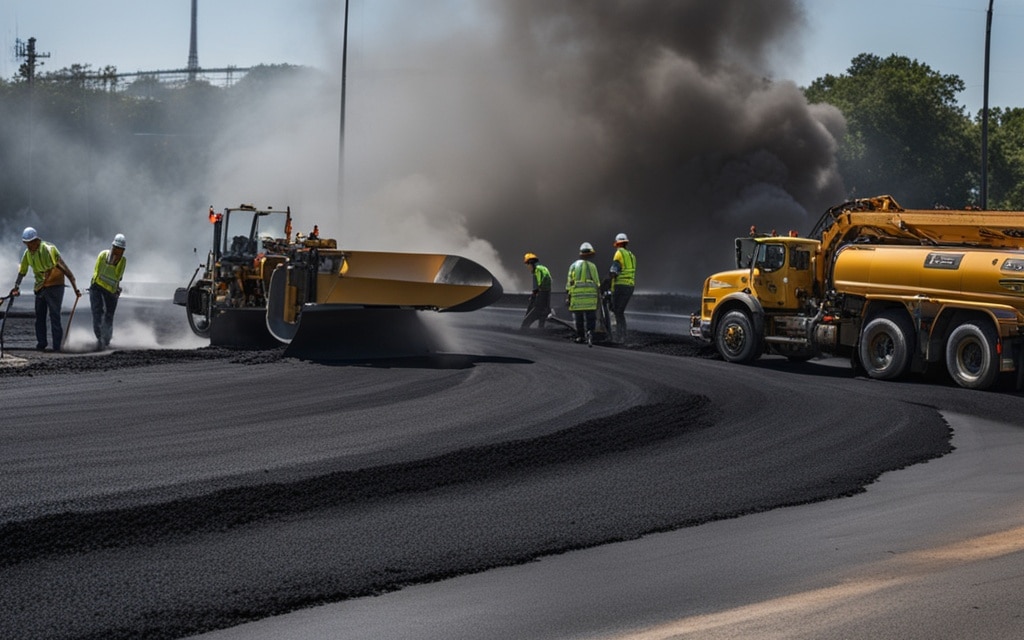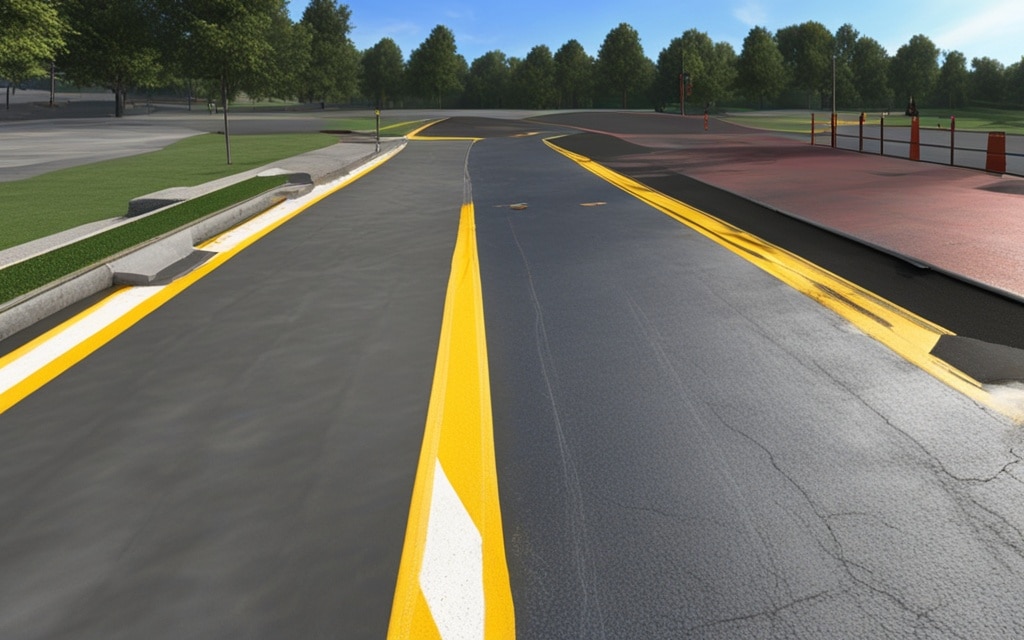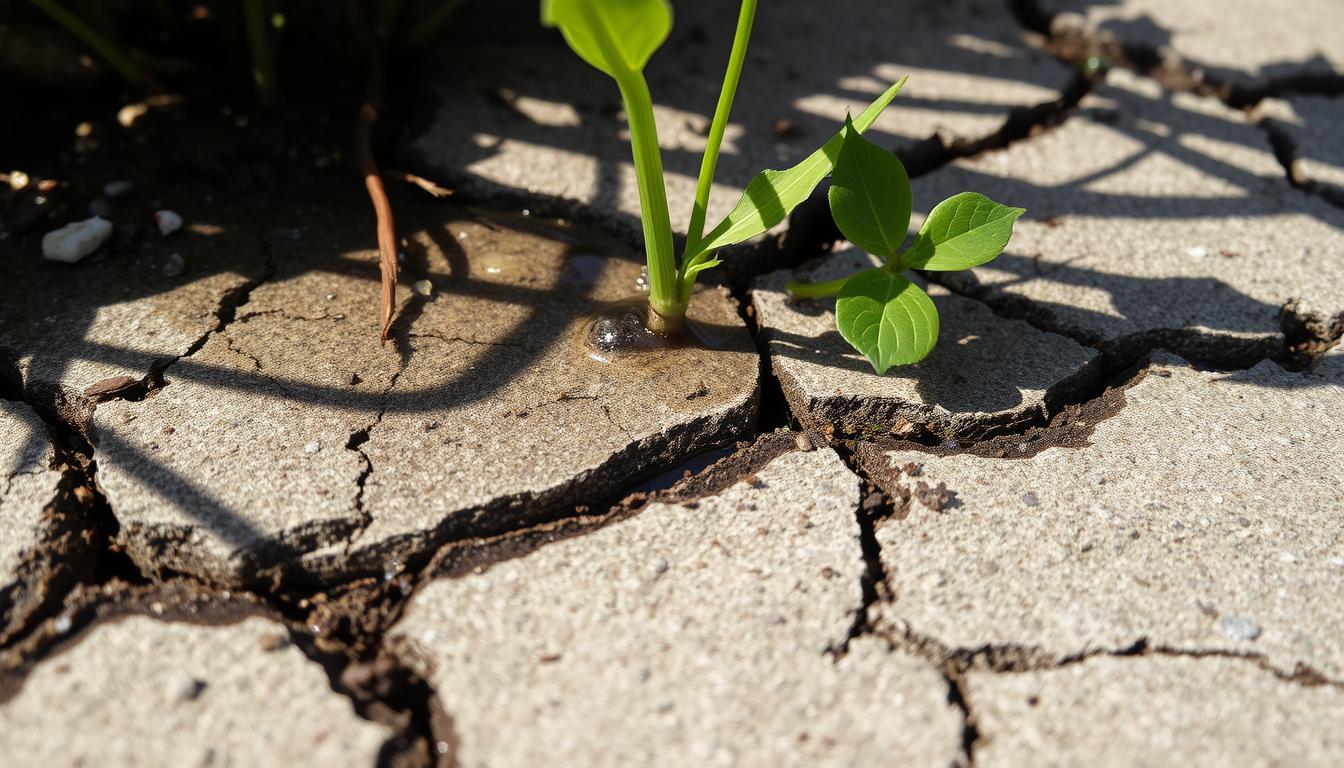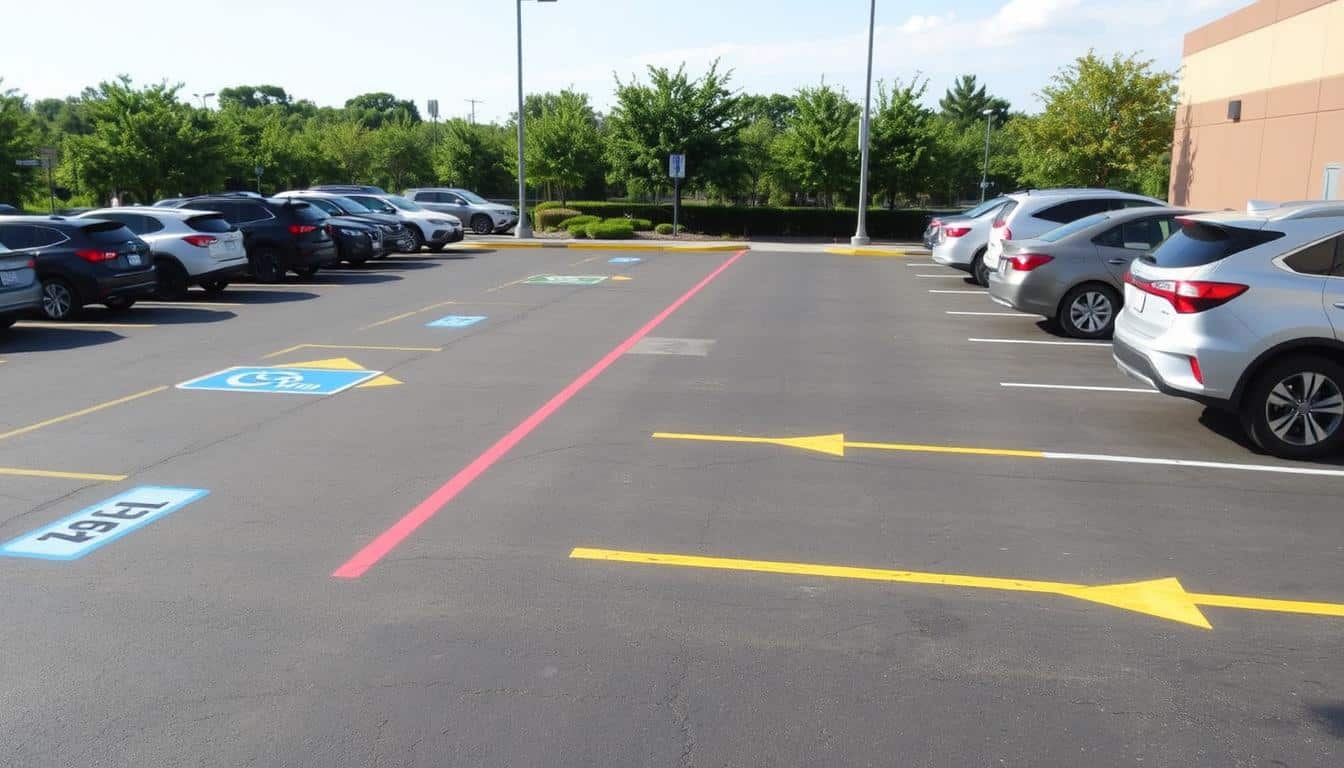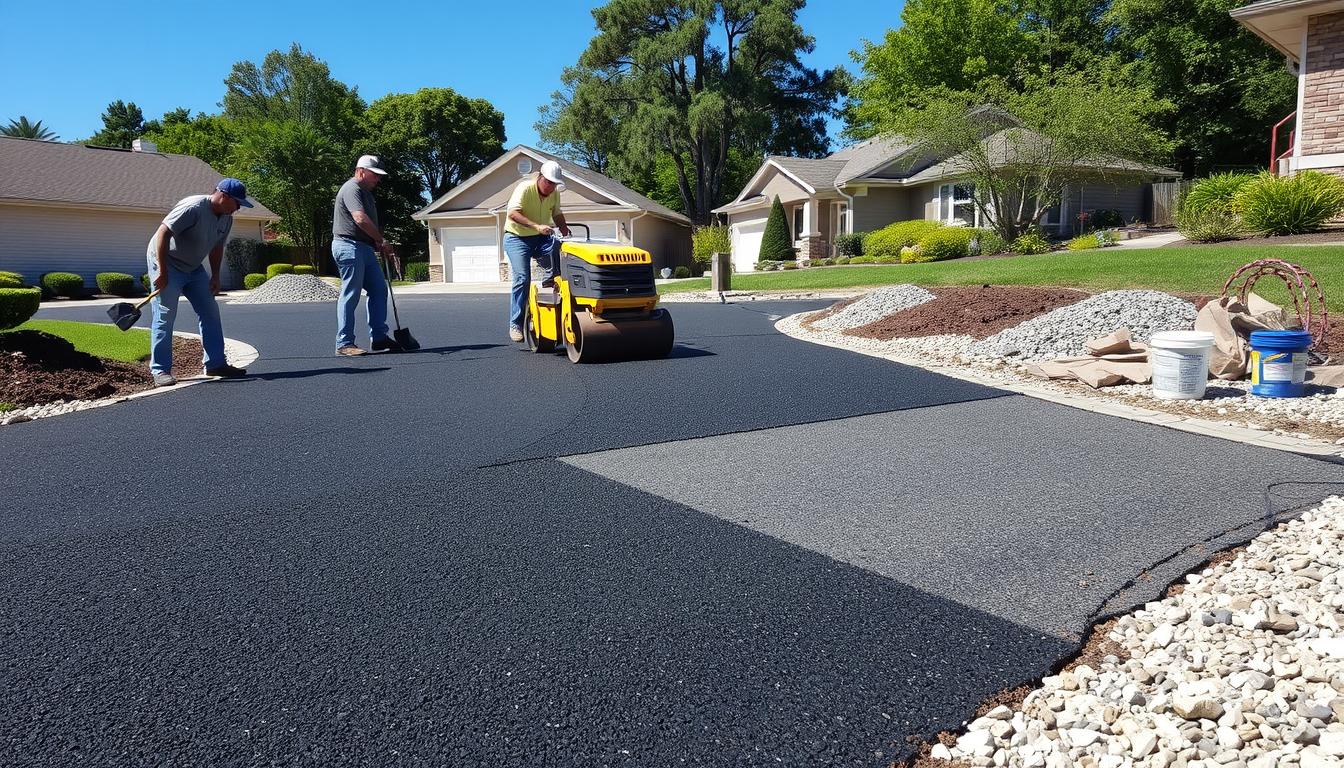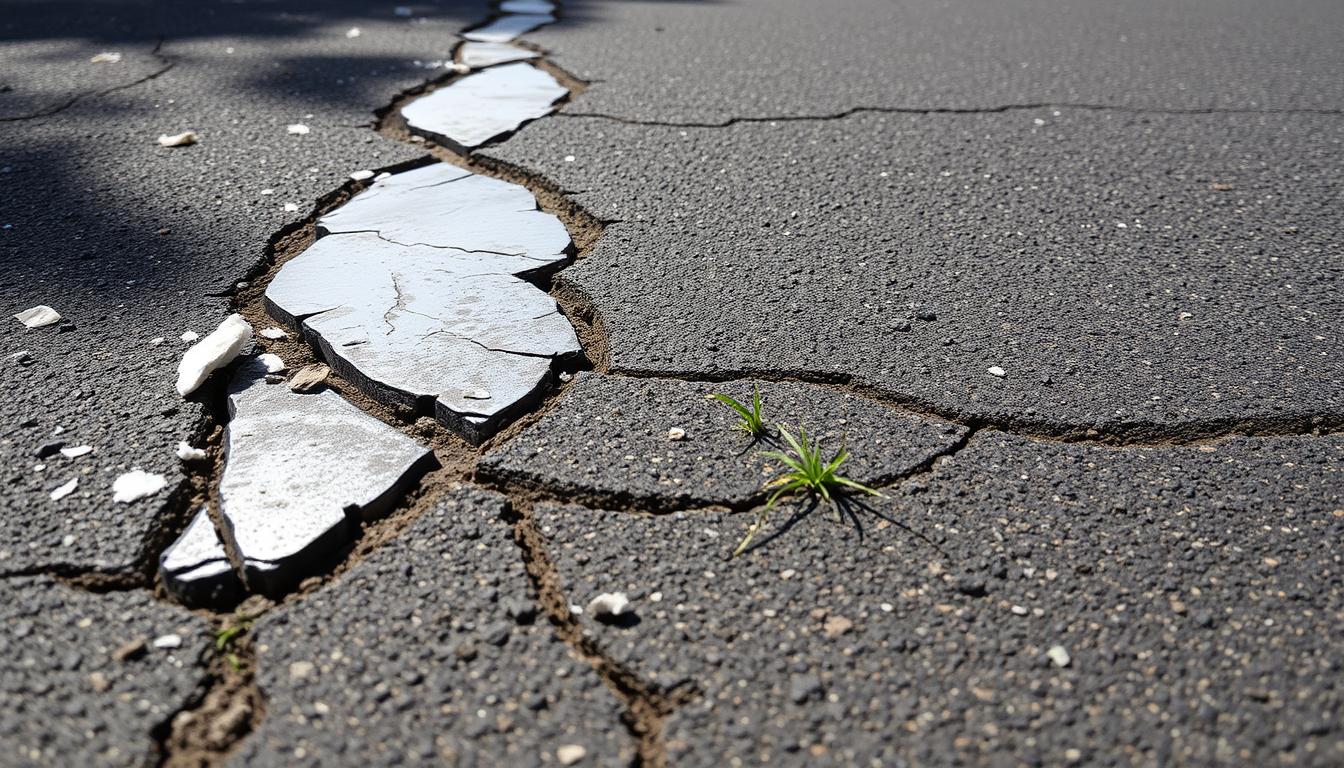Tired of always fixing or changing your road pavements? Want a low-cost way to make your roads last longer and drive smoother and safer? Try asphalt patching.
This method fixes cracks, potholes, and other issues in your pavement. By fixing these problems early, you can avoid the big cost of replacing the whole surface. This saves you money, time, and the hassle of major repairs.
Key Takeaways:
- Asphalt patching can extend the life of roads and prevent the need for costly pavement replacement.
- Understanding the pros and cons of different asphalt repair methods is key to finding the best option for your situation.
- Proactively addressing cracks, potholes, and other forms of damage can ensure smoother, safer drives.
- Choose asphalt patching to save time, money, and inconvenience caused by extensive road repairs.
- Consider the specific needs of your pavement to select the most suitable asphalt patching technique.
- Contact HT Paving for all your asphalt needs in San Mateo, CA and surrounding areas.
Asphalt Reconstruction vs. Patching: Pros and Cons
When fixing asphalt, you often choose between reconstruction and patching. Each way has its good sides and things to think about. So, it’s smart to know the ups and downs of each before picking one.
Asphalt Reconstruction:
Reconstruction means pulling out old asphalt and putting in new. It also fixes the layers underneath. This big fix is for when the road has serious wear or big problems. New asphalt makes the road stronger and last longer against heavy use and bad weather.
But, this method costs more than patching. Also, it takes longer, which can slow down traffic and bother nearby places. So, think about budget and time carefully if you choose this.
Asphalt Patching:
Patching only fixes small areas of damage. This choice is cheaper and won’t take so long. It works well for some cracks and small holes or if you’re watching your budget.
Yet, patching may not work for lots of damage or if there’s a big problem underneath. Even if it helps for a while, it doesn’t strengthen the road as much as starting fresh with new asphalt.
Choosing between reconstruction and patching is up to your needs and what you can spend. Reconstruction is great for serious problems and lasting strength. On the flip side, patching is a good option for saving money and quick fixes in some spots.
Asphalt Patching Techniques for Different Situations
Asphalt repair involves various methods based on the damage’s extent. Picking the best patching approach is key for lasting and efficient results. Here are four common ways to patch asphalt:
Throw-and-roll
The throw-and-roll method is perfect for quick fixes during bad weather. It fills the damaged area with asphalt mix, then compacts it with heavy machinery. This approach works well as a temporary solution, buying time until a lasting repair can be made.
Semi-permanent patches
Semi-permanent patches offer a more lasting fix for asphalt damage. They require thorough prep: the area is cleaned, loose bits are removed, and a tack coat is applied. After that, a suitable mix is used to fill the damage, and everything is compacted. This method lasts longer and looks better than throw-and-roll, ideal for roads with moderate traffic.
Spray injection method
The spray injection method is great for fixing asphalt issues in tough conditions. It uses special gear to clean and fill the damaged spot with an emulsion-based mix. This mix blends with the existing asphalt for a strong, durable repair. It doesn’t need compaction, making it perfect for hard-to-reach areas.
Full-depth patching
Full-depth patching is the top choice for extensive damage or structural problems. It involves digging up the damage, including the subbase, and replacing these parts. This creates a solid base for a new layer and ensures a lasting fix. It’s mainly used on high-traffic areas or where the damage is severe.
It’s vital to choose the right patching method to solve pavement problems correctly. When picking a method, consider the damage scale, the road’s traffic, and your budget. With the right selection and approach, your asphalt surfaces will stay functional and last a long time.
Choosing the Right Repair Method for Your Asphalt
Aside from rebuilding and patching, you have other good ways to deal with asphalt problems. When you need a quick fix, resurfacing is a smart choice because it’s cost-effective. It means putting a fresh layer of asphalt on top, which makes your pavement usable again fast.
To keep your asphalt lasting longer, crack sealing and sealcoating are key steps. Crack sealing stops the damage from spreading by closing up the pavement’s cracks. This keeps out water and other harmful stuff. Sealcoating adds an extra layer that guards your pavement from the sun, bad weather, and chemicals.
For roads with moderate traffic, chip sealing is a budget-friendly method. It seals the cracks and puts down a stone layer. This helps your pavement last longer and be tougher.
If you’re looking at other options, consider using asphalt rejuvenators. They’re made to add flexibility back to the asphalt and cut down on cracks. Rejuvenators can make your pavement last longer and avoid serious repairs. Don’t forget, keeping your pavement clean and clear of debris is essential. It helps stop damage and keeps your pavement strong.
When picking the best repair for your asphalt, think about what your pavement really needs. From resurfacing to regular cleaning, each method is important for keeping your asphalt in good shape. By choosing the right techniques, you can keep your pavement healthy and last longer.
Contact HT Paving for all your asphalt needs in San Mateo, CA and surrounding areas.
FAQ
What is asphalt patching?
Asphalt patching fixes cracks, potholes, and other damage. It’s a way to repair the pavement without replacing the whole surface.
How does asphalt patching extend the life of roads?
It makes the road smoother and safer by fixing the bumps and holes. This work makes the road last longer before needing a big repair.
What are the pros and cons of asphalt reconstruction?
Reconstruction fixes major problems by replacing the old with new asphalt. It makes the road stronger but costs more and takes longer.
What are the advantages of patching?
Patching is quick and focused on specific damaged spots. It’s cheaper and doesn’t cause as much traffic trouble as full reconstruction.
What are the different asphalt patching techniques?
Patching can be done in a few ways. There’s a quick method for short-term needs and deeper fixes for long-term use. A method using a spray is good in bad weather. For very bad spots, they might dig down to the base before fixing it.
How do I choose the right repair method for my asphalt?
Start with your needs and what you can spend. You can pick from different methods, like covering cracks or doing a full fix. Think about what each choice can do for your pavement’s health.

